
- •Central Nervous System
- •Introduction
- •The Brain
- •The Brain
- •Embryonic Development
- •Embryonic Development
- •Development of Neural Tube
- •Development of Neural Tube
- •Development of Neural Tube
- •Development of Neural Tube
- •Primary Brain Vesicles
- •Secondary Brain Vesicles
- •Secondary Brain Vesicles
- •Secondary Brain Vesicles
- •Secondary Brain Vesicles
- •Secondary Brain Vesicles
- •Secondary Brain Vesicles
- •Adult Neural Canal Regions
- •Development of Flexures
- •Effects of Space Restriction
- •Effects of Space Restriction
- •Effects of Space Restriction
- •Effects of Space Restriction
- •Regions of the Brain
- •Gray and White Matter in CNS
- •Gray and White Matter in CNS
- •Gray and White Matter in CNS
- •Ventricles of the Brain
- •Ventricles of the Brain
- •Ventricles of the Brain
- •Ventricles of the Brain
- •Ventricles of the Brain
- •Ventricles of the Brain
- •Ventricles of the Brain
- •Ventricles of the Brain
- •The Cerebral Hemispheres
- •The Cerebral Hemispheres
- •The Cerebral Hemispheres
- •Lobes of Cerebral Hemispheres
- •Lobes of Cerebral Hemispheres
- •Fissures of Cerebral Hemispheres
- •Medial Surface of Right Hemisphere
- •Position of Cerebral Hemispheres
- •Cerebral Cortex
- •Cerebral Cortex
- •Cerebral Cortex
- •Cerebral Hemispheres
- •Cerebral Cortex
- •Cerebral Cortex Generalizations
- •Cerebral Cortex Generalizations
- •Motor Areas
- •Primary Motor Cortex
- •Pyramidal cells
- •Pyramidal Tracts
- •Motor
- •Motor
- •Motor
- •Premotor Cortex
- •Premotor Cortex
- •Premotor Cortex
- •Premotor Cortex
- •Broca’s area
- •Broca’s area
- •Frontal Eye Field
- •Sensory Areas
- •Primary Somato sensory Cortex
- •Synaptic Chain
- •Primary Somato sensory Cortex
- •Motor and Sensory Somatotopy
- •Primary Somato sensory Cortex
- •Primary Somato sensory Cortex
- •Primary Somatosensory Cortex
- •Somatosensory
- •Somatosensory
- •Somatosensory
- •Primary Visual
- •Primary Visual Cortex
- •Primary Visual
- •Primary Visual
- •Primary Visual Cortex
- •Visual Association
- •Visual Association
- •Visual Association Area
- •Visual Association Area
- •Visual Association Area
- •Visual Association Area
- •Visual Areas
- •Primary Auditory Cortex
- •Primary Auditory Cortex
- •Auditory Association Area
- •Auditory Association Area
- •Auditory Association Area
- •Gustatory (taste) Cortex
- •Vestibular (equilibrium) Cortex
- •Olfactory Area
- •Olfactory Area
- •Olfactory Area
- •Olfactory Area
- •Olfactory Area
- •Olfactory Area
- •Association Areas
- •Association Areas
- •Prefrontal Cortex
- •Prefrontal Cortex
- •Prefrontal Cortex
- •Prefrontal Cortex
- •Prefrontal Cortex
- •Prefrontal Cortex
- •Prefrontal Cortex
- •Prefrontal Cortex
- •Prefrontal Cortex
- •Prefrontal Cortex
- •Prefrontal Cortex
- •General Interpretation Area
- •Language Area
- •Language Area
- •Language Area
- •Insula
- •Lateralization of Cortical Function
- •Lateralization of Cortical Function
- •Lateralization of Cortical Function
- •Lateralization of Cortical Function
- •Cerebral White Matter
- •Cerebral White Matter
- •Cerebral White Matter
- •Cerebral White Matter
- •Cerebral White Matter
- •Cerebral White Matter
- •Cerebral White Matter
- •Cerebral White Matter
- •Basal Nuclei
- •Basal Nuclei
- •Basal Nuclei
- •Basal Nuclei
- •Basal Nuclei
- •Basal Nuclei
- •Basal Nuclei
- •Basal Nuclei
- •Basal Nuclei
- •Basal Nuclei
- •Basal Nuclei
- •The Diencephanlon
- •The Diencephalon
- •The Diencephalon
- •Thalamus
- •Thalamus
- •The Thalamus
- •Thalamus
- •Thalamus
- •Thalamus
- •Thalamus
- •Thalamus
- •Thalamus
- •The Hypothalamus
- •Hypothalamus
- •Mammillary Bodies
- •Hypothalamus
- •Hypothalamus
- •Autonomic Control Center
- •Center for Emotional Response
- •Center for Emotional Response
- •Body Temperature Regulation
- •Body Temperature Regulation
- •Body Temperature Regulation
- •Regulation of Hunger & Thirst
- •Regulation of Water Balance
- •Regulation of SleepWake Cycles
- •Regulation of SleepWake Cycles
- •Control of Endocrine Functioning
- •Formation of Memory
- •Epithalamus
- •The Epithalamus
- •Epithalamus
- •The Epithalamus
- •The Brain Stem
- •The Brain Stem
- •The Brain Stem
- •The Midbrain
- •The Midbrain
- •The Midbrain
- •The Midbrain
- •The Midbrain
- •The Midbrain
- •The Midbrain
- •The Midbrain
- •The Midbrain
- •The Midbrain
- •The Midbrain
- •The Midbrain
- •The Midbrain
- •The Midbrain
- •The Midbrain
- •The Midbrain
- •The Midbrain
- •The Pons
- •The Pons
- •The Pons
- •The Pons
- •The Pons
- •The Pons
- •The Medulla Oblongata
- •The Medulla Oblongata
- •The Medulla Oblongata
- •The Medulla Oblongata
- •The Medulla Oblongata
- •The Medulla Oblongata
- •The Medulla Oblongata
- •The Medulla Oblongata
- •The Medulla Oblongata
- •The Medulla Oblongata
- •The Medulla Oblongata
- •Medulla
- •The Medulla Oblongata
- •The Medulla Oblongata
- •The Medulla Oblongata
- •The Medulla Oblongata
- •The Medulla Oblongata
- •The Medulla Oblongata
- •The Cerebellum
- •The Cerebellum
- •The Cerebellum
- •The Cerebellum
- •The Cerebellum
- •The Cerebellum
- •The Cerebellum
- •The Cerebellum
- •The Cerebellum
- •The Cerebellum
- •The Cerebellum
- •The Cerebellum
- •The Cerebellum
- •The Cerebellum
- •The Cerebellum
- •The Cerebellum
- •The Cerebellum
- •The Cerebellum
- •The Cerebellum
- •The Cerebellum
- •The Cerebellum
- •The Cerebellum
- •Cerebellar Processing 1
- •Cerebellar Processing 2
- •Cerebellar Processing 3
- •Cerebellar Processing 4
- •The Cerebellum
- •The Cerebellum
- •Functional Brain Systems
- •The Limbic System
- •The Limbic System
- •The Limbic System
- •The Limbic System
- •The Limbic System
- •The Limbic System
- •The Limbic System
- •The Limbic System
- •The Limbic System
- •The Limbic System
- •The Limbic System
- •The Limbic System
- •The Limbic system
- •The Limbic System
- •The Limbic System
- •The Reticular Formation
- •The Reticular Formation
- •The Reticular Formation
- •The Reticular Formation
- •The Reticular Formation
- •The Reticular Activating System
- •Reticular Formation
- •The Reticular Activating System
- •The Reticular Formation
- •Protection of the Brain
- •Meninges
- •Meninges
- •Meninges
- •Meninges
- •The Dura Mater
- •The Dura Mater
- •The Dura Mater
- •The Dura Mater
- •The Dura Mater
- •The Dura Mater
- •The Dura Mater
- •The Arachnoid Mater
- •The Arachnoid Mater
- •The Arachnoid Mater
- •The Pia Mater
- •Cerebrospinal Fluid (CSF)
- •Cerebrospinal Fluid (CSF)
- •Choroid Plexus
- •Choroid Plexus
- •Choroid Plexus
- •The Choroid Plexus
- •CSF Circulation
- •CSF Circulation
- •BloodBrain Barrier
- •BloodBrain Barrier
- •BloodBrain Barrier
- •BloodBrain Barrier
- •BloodBrain Barrier
- •Homeostatic Imbalances
- •The Brain
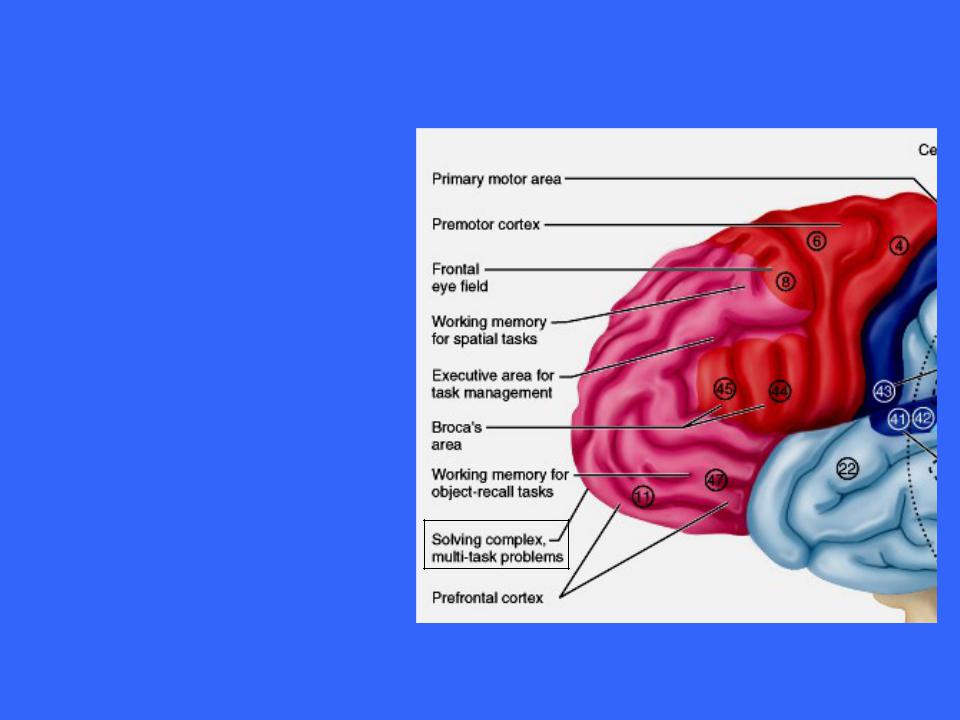
Prefrontal Cortex
The extreme anterior pole of the frontal cortex was found to be active in solving the most complex problems problems in which many sub problems had to be completed before a solution could be obtained

Prefrontal Cortex
The new findings suggest support for a general rule of neuroscience that says the farther rostrally one goes in the CNS, the more complex are the neuron functions performed
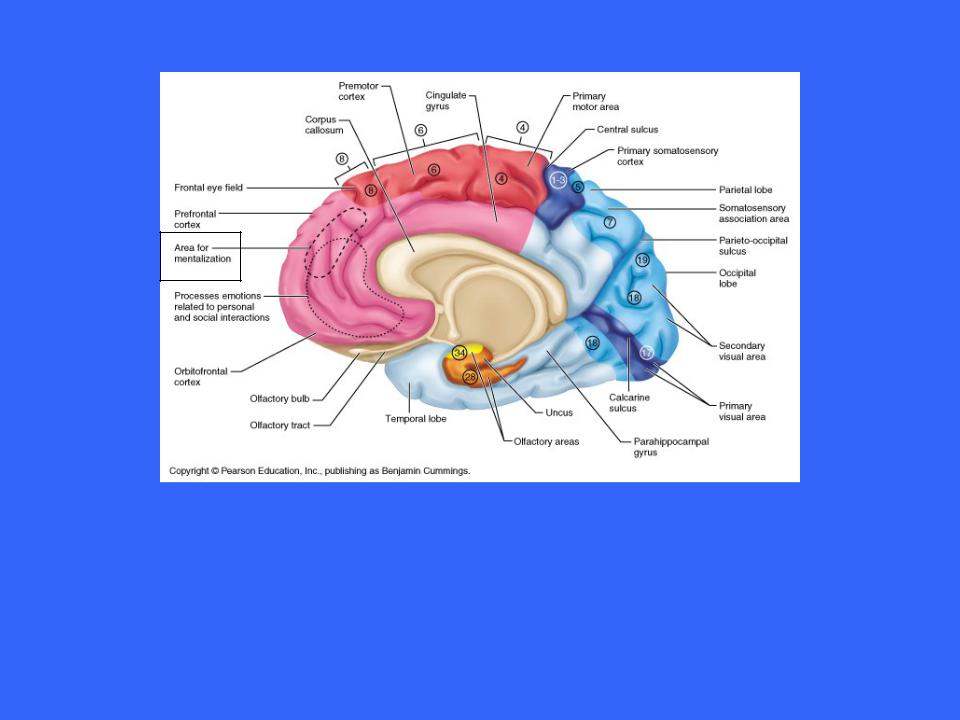
Prefrontal Cortex
The area just anterior to the corpus callosum may process emotions involved in “mentalization”, the ability to understand and manipulate other people’s thoughts and emotions
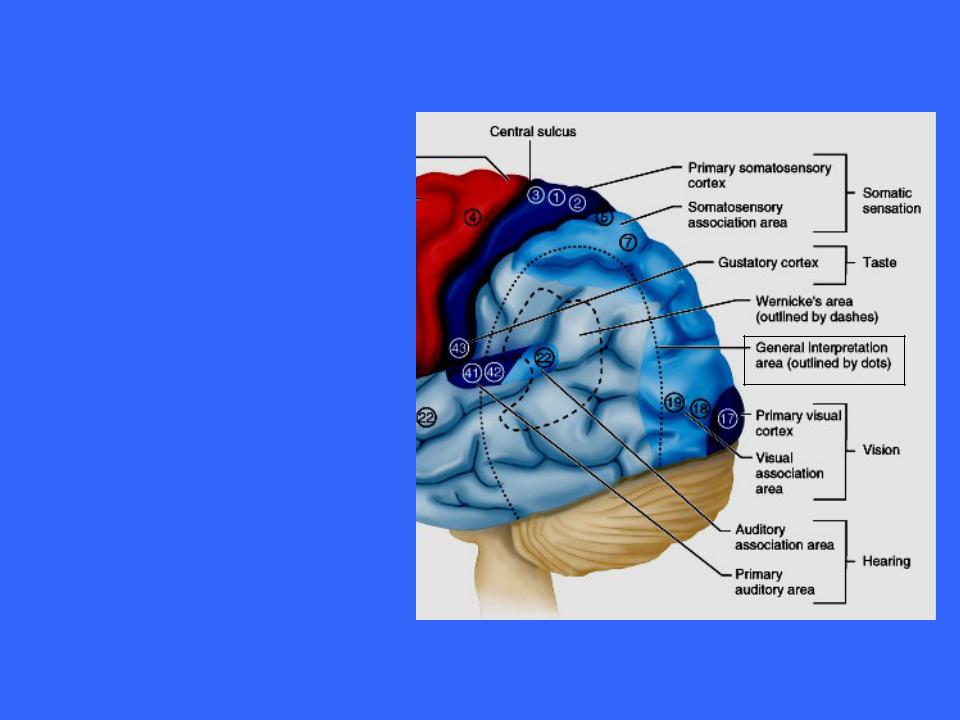
General Interpretation Area
The existence of this area within the brain is debated
Once thought to be an area of integration of all types of sensory information, its existence was mainly substantiated by agnosia (not knowing)
Recent studies do not support its presence
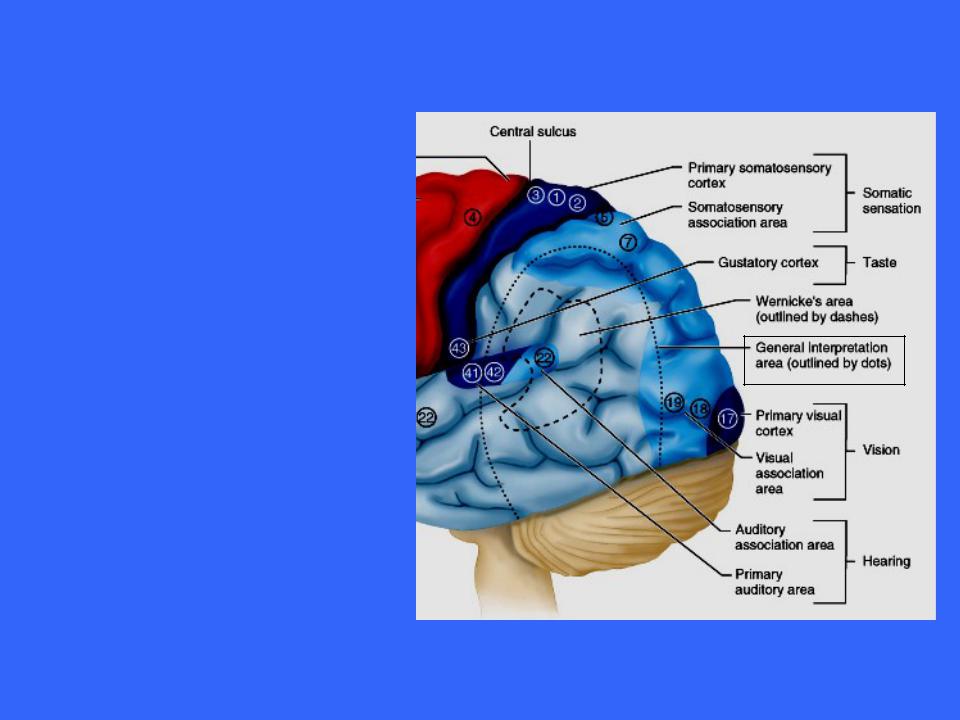
Language Area
The large area surrounding the lateral sulcus in the left cerebral hemisphere is involved in various functions related to language
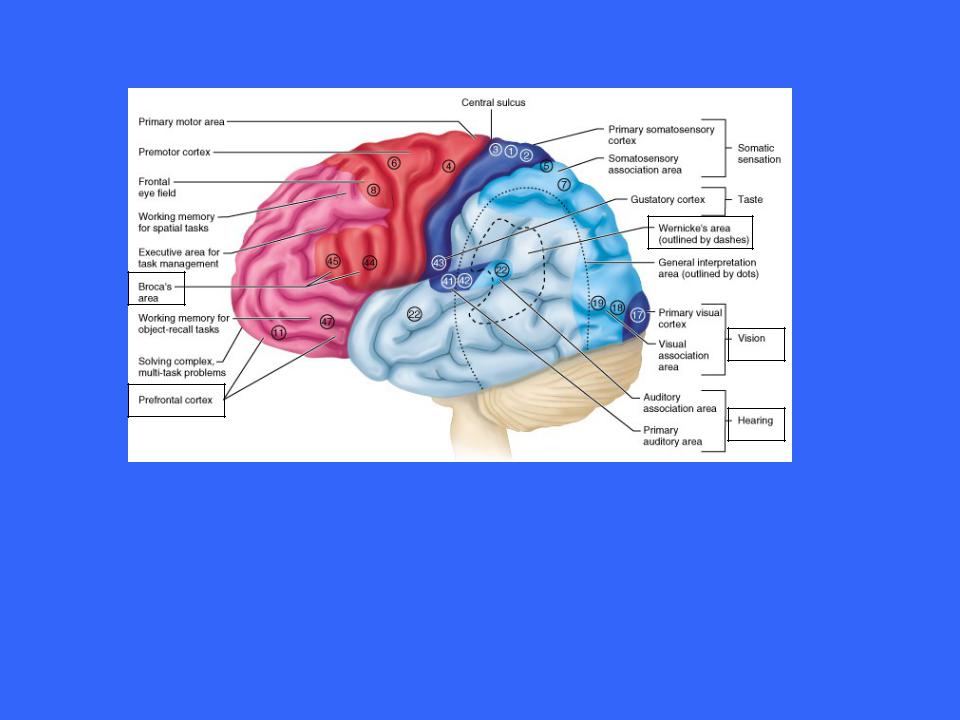
Language Area
Five areas have been identified with language; Broca’s area (speech production); Wernicke’s area (speech comprehension); prefrontal cortex (conceptual analysis); temporal lobe (visual and auditory aspects of language ); the insula (recognition of rhythms)
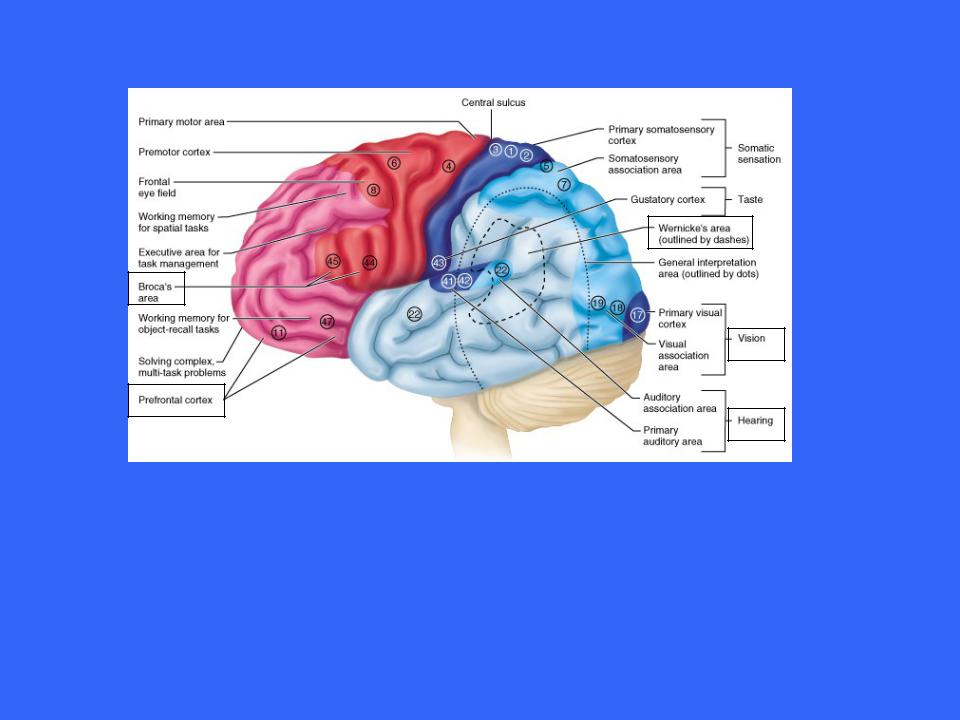
Language Area
The corresponding areas on the right hemisphere, although not involved in the mechanics of language, act in the creative interpretation of words and in controlling the emotional overtones of speech
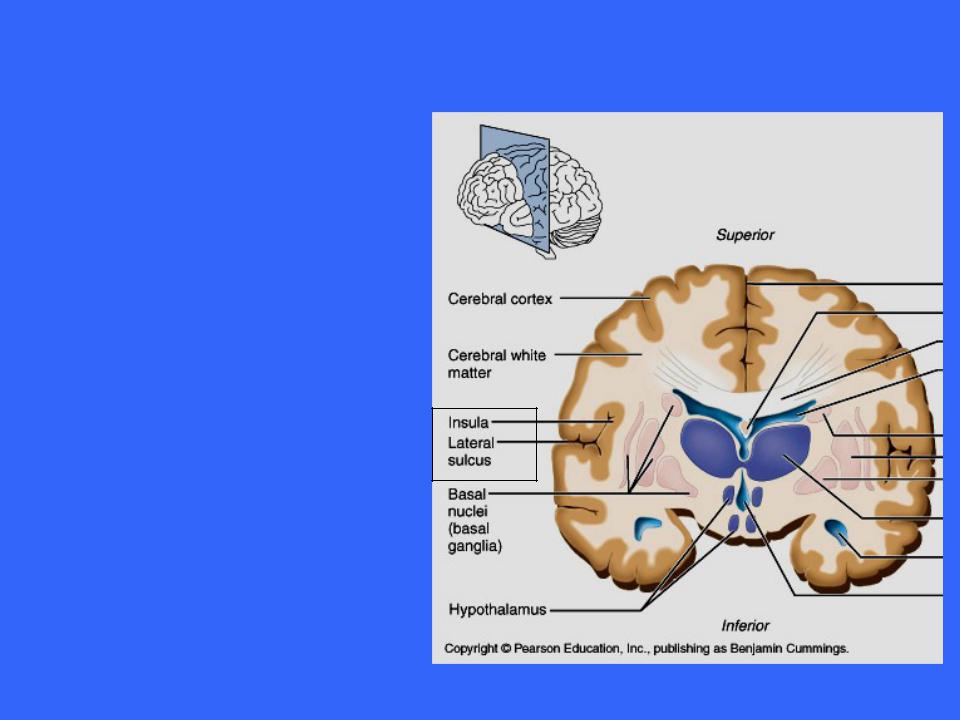
Insula
The insula is large and the functions of its cortex are not well understood
Some parts function in language and some in the sense of balance
Other parts have visceral function including the perception of upset stomach, full bladder

Lateralization of Cortical Function
We use both cerebral hemispheres for almost every task and it appears the hemispheres share memories and appear nearly identical
However, there are differences and unique abilities that are found in one hemisphere and not the other
This phenomenon is call lateralization
Cerebral dominance suggest that there is one hemisphere that dominates each task

Lateralization of Cortical Function
In most people (Approx. 90%) the left hemisphere has greater control over language abilities, mathematical abilities, and logic
The other hemisphere (usually the right) is involved in visualspatial skills, intuition, emotion, and appreciation of art and music
